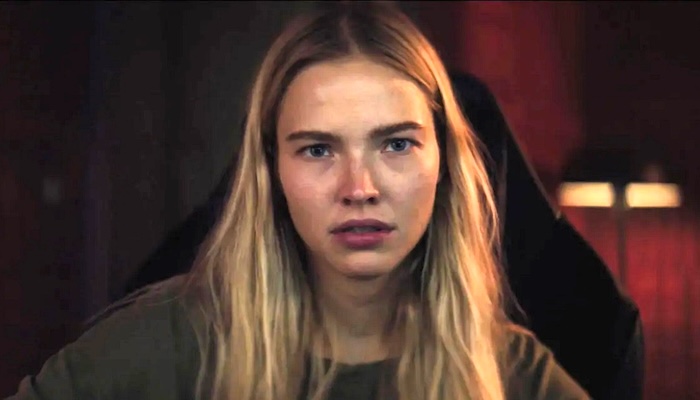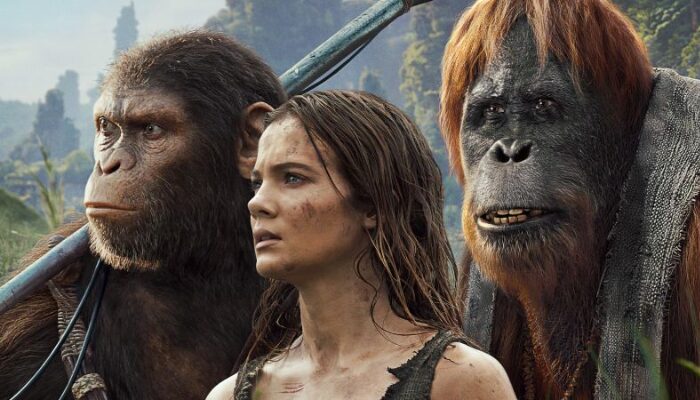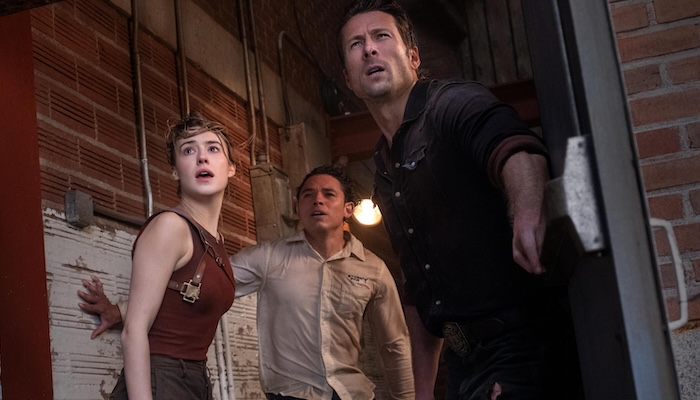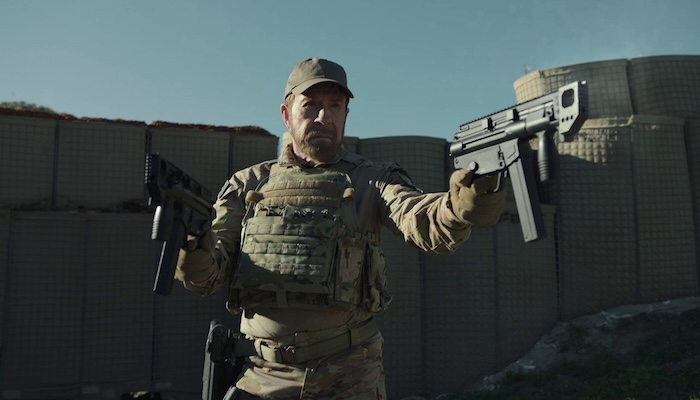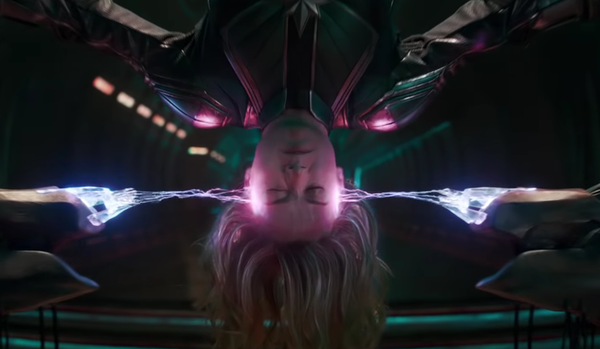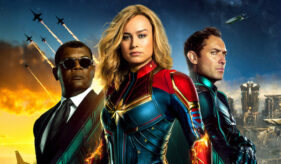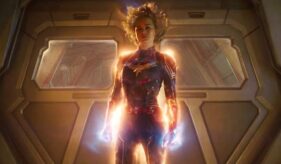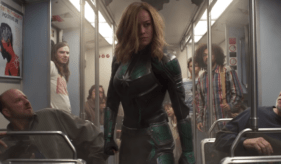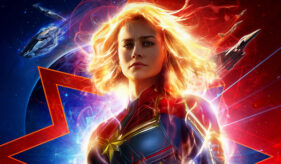Film Review: CAPTAIN MARVEL (2019): An Empty Origin Story Movie that Steadily Declines into Boredom
Table of Contents
The Skrull Trap
The Skrull’s trap on Torfa is a badly written plot-point. Who are the Skrulls trying to ensnare with their trap? It can’t be Vers. The Skrulls have no way of knowing that it will be her Starforce unit sent to Torfa to exfiltrate the Kree spy. So if not Vers, who are the Skrulls trying to capture with their Torfa trap? Did the Skrulls execute all of that artifice to trap some random Starforce soldier?
It’s not that the Skrulls are morons. They are not to blame for this idiotic plot-point. It’s the writers behind this plot-point, Anna Boden, Ryan Fleck, and Geneva Robertson-Dworet, whom are the culprits. These same writers also believe that the viewer is blind and will not see the profound logic problem that this plot-point represents.
Once again, and please remember, this takes place in the good portion of Captain Marvel. Everything up to this point is forgiven, even the Skrulls’ nonsensical trap. With any film, however, there is a breaking-point where the bad equals, then exceeds, the good. The “equals” portion of this transition period happens during what should be one of the best moments in Captain Marvel – Vers waking up on a Skrull ship and her subsequent escape. After she breaks out of her restraints, the “bad exceeds the good” portion of Captain Marvel‘s script begins multiplying like an infection to such an exponential degree that it is impossible to ignore, forgive, and not laugh at in the most derisive way.
The Memory Dump
What starts as an intriguing and serious scene with Vers’ blocked memories being probed by the Skrulls quickly turns comical a situation that should otherwise be gripping and perilous.
Unlike when Tony Stark fights to free himself in an Afghanistan cave in Iron Man, Vers’ break for freedom on the Skrull ship has zero tension. The moment Vers gets free, it’s either a slap-stick display or she beats everyone up with ease. In the Tony Stark scene, there was a suspension of disbelief. The viewer did not know if Tony Stark was going to survive because the odds were so stacked against him and he had so few resources at his disposal. Stark was the underdog, the funny, charismatic guy thrown into a situation in which a single wrong turn would be his end.
Vers, on the other hand, is carefree during her break-out attempt, as if she is jogging through a mall with upset mall guards on her heels. There is no challenge to her escape, or fear, or risk of failure. If the character on-screen can not care less about the perilous situation they are in, why should the viewer? Vers’ reaction to her predicament takes the viewer completely out of the scene to the point of non-engagement. The viewer is reduced to watching a person with no shoes on run around the screen as laughably-inept Putty Patrollers show up to get beaten up.
For all intents and purposes, this scene is a harbinger of what is to come in Captain Marvel.
– Non-review Aside Begins –
When Vers corners Talos (Ben Mendelsohn) and asks why he put all this stuff in her head and he retorts the memories had always been there (to paraphrase), a very interesting response in that moment would have been if Vers demanded that her mind to be restored to its previous state, to the puzzlement and chagrin of Talos. Vers would have been aware, even then, that she didn’t want the images and feelings that were now floating through her mind, that she wanted to be the current version of herself. This would have instituted a parallel story-line in Captain Marvel – while there was an external struggle going on in the film around Vers, there would have been an substantive internal one going on within her as well.
A different way to handle the “Vers Request” would have been for Vers not to make the aforementioned request of Talos (which would, admittedly, be lunacy) but to make the request of Yon-Rogg when she calls him from C-53.
Vers tells Yon-Rogg what happened with the mind probe, that she thinks that it isn’t a Skrull trick. That she can feel this person, this stranger. That the person in these memories is real and that she is that person. That she is being overwhelmed with nameless ghosts and situations that seem as alien to her as C-53.
As she speaks, Yon-Rogg listens patiently, intently. Then Vers asks “Can Super Intelligence put my mind back the way it was?”
“It can try Vers. Remember your training. It will help you.”
Then, like in the film, Yon-Rogg tells Vers to stay put, to marshal her impulses, and for Att-Lass (Algenis Pérez Soto) to max out the engines to get them to C-53 as soon as possible. Yon-Rogg then clasps his hands under his chin thinking to himself, worried about the student that he has grown fond of and the potential enemy that lurks within her.
– Non-review Aside Ends –
This sequence and subtext would have added another layer to Vers, Yon-Rogg, and Captain Marvel, whom like almost every other element in the film, are in desperate need of depth.
The Impact Inconsistency
Vers coming to C-53 (Earth) in Captain Marvel, like Steve Rogers being transported from 1942 to 2011 in Captain America: The First Avenger, is inevitable. What is not inevitable in Captain Marvel is the gigantic inconsistency that it presents to the viewer during the Skrull-ship-to-Earth transit scene. If Vers can not get hurt by falling from the sky through the roof of a Blockbuster video store, slamming against the floor underneath it (with no physical damage whatsoever), how does Yon-Rogg make Ver’s nose bleed during their sparing match? It is a complete contradiction. So Vers can get hurt by a simple punch to the face but falling through metal and wood at 60-90 miles-per-hour and being bashed up against concrete at the conclusion of the fall causes no physical damage?
The question that you are asking yourself is how does Captain Marvel‘s writers explain this contradiction in the film? This is how they explain it – they don’t. Instead, they either expect the viewer not to notice or if they do notice, not to care.
In Avengers: Infinity War, when the Outriders rip into Iron Man’s Hulkbuster armor with their claws and teeth yet use neither on the flesh and blood characters, the viewer doesn’t notice because so much is going on all at once. In Captain Marvel, when the aforementioned contradiction occurs, its just Vers on-screen. There is no distraction from the massive refutation that the viewer sees. It just sits there for the viewer to mull over in their mind and mouth like a wad of foul-tasting phlegm.
When a film breaks its own rules, it breaks its ability to tell a credible story and destroys the trust the viewer has in the screenwriter and the film. If a screenwriter introduces a cause and effect then violates that rule in another scene, what is the viewer really watching? An exercise in antithetical screenwriting?
The Fish Out of Water
Vers on Earth, because of the memory wipe, should be the brilliant fish-out-of-water segment of Captain Marvel, like Diana Prince in Europe in Wonder Woman or the U.S.S. Enterprise crew in San Francisco in Star Trek IV: The Voyage Home. Vers on Earth should be one of the most rewarding and comedic sections of Captain Marvel. Instead, the-fish-out-of-water segment of Captain Marvel is scene-after-scene of a badly written, constructed, and acted narrative.
The latter lands squarely on Brie Larson’s shoulders. Her dialogue and accompanying facial expressions from the moment she bumps into a security guard to the moment the Skrull on the train escapes, are incongruous, odd, and out of place to: a.) the situations (e.g. why does she smirk at the old man, Stan Lee, on a train filled with innocent bystanders while hunting a killer alien soldier? What’s humorous about that?) and b.) the type of person she is (intergalactic military and an amnesiac).
When it comes to writing and scene construction, there is a choppiness and idiocy to the early Earth events in Captain Marvel: Example 1.) Vers just takes S.H.I.E.L.D. Agent Nick Fury (Samuel L. Jackson )’s word on it that he is Earth law enforcement when she is dealing with shape-shifting aliens? Example 2.) How is an trained U.S. Air Force pilot and Kree Starforce soldier restrained by a gaggle of untrained civilians on a locomotive? Vers knows a myriad of wrist moves and take-downs and doesn’t use any of them to free herself so she can capture or kill her target? Why? Example 3.) Instead of punching the old lady Skrull, why doesn’t Vers use her Photo Blast and kill the Skrull on the spot in the train? Her objective is to stop the Skrulls from getting the light-speed engine and she starts a banal fist fight with a Skrull (who just tried to kill her) when she has two lethal weapons at her disposal?
When faced with this level of incomprehensibility and utter degradation of the screenwriting profession, the faithful fanboy may acknowledge the above, chew his or her popcorn, mutter something about Avengers: Endgame, and concentrate on the explosions and fist-i-cuffs present in Captain Marvel. This is probably a wise move since they already paid $15-$20 to see the film in-theater. The connoisseur of the superhero genre who does not deign to shut off his or her brain, however, will see this entire section of the film as a magnificently wasted opportunity created by dolts who unfortunately carry the moniker of ‘screenwriter.’
The S.H.I.E.L.D. Continuity Error
Did anyone proof read the screenplay to Captain Marvel before it was finalized into the shooting script?
If someone did, how does that person or group of people, explain the S.H.I.E.L.D. inconsistency between Iron Man and Captain Marvel? In Iron Man, which takes place after Captain Marvel in the Marvel Cinematic Universe timeline, the running joke in that film is that Agent Phil Coulson (Clark Gregg) constantly refers to the organization that he works for as the “Strategic Homeland Intervention, Enforcement and Logistics Division.” It is only in the third act of Iron Man that Coulson announces that the organization now goes by the acronym S.H.I.E.L.D.
In Captain Marvel, Agent Coulson and Fury both call the Strategic Homeland Intervention, Enforcement and Logistics Division “S.H.I.E.L.D.” when talking about the organization they work for, thirteen years before that acronym is created in Iron Man.
How is that possible?
This is a major instance of sloppy writing, copy-editing, and script supervision by Marvel Studios during the production of Captain Marvel. How did this make it into the film? Did any of the people that wrote this lackadaisical script actually see Iron Man? Did anyone who rehearsed this script see Iron Man and point out this blatant continuity inconsistency? Doesn’t Marvel Studios have a M.C.U. historian that reads film scripts before they roll into production to catch continuity errors like this? If not, they should. Marvel made themselves look like amateurs with this unforced error.
Related Articles
FilmBook's Newsletter
Subscribe to FilmBook’s Daily Newsletter for the latest news!

